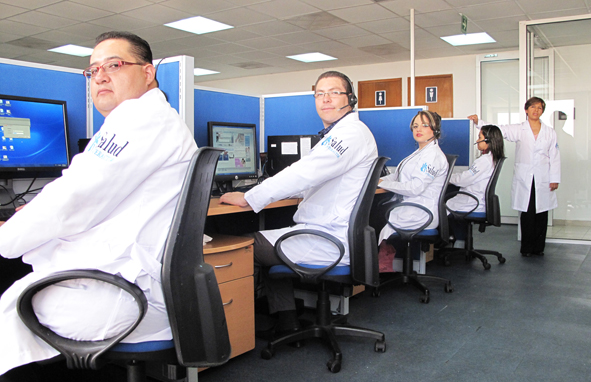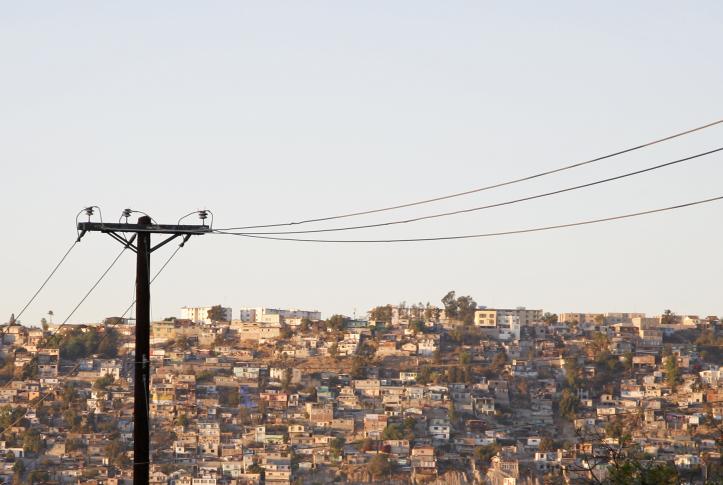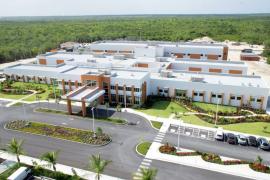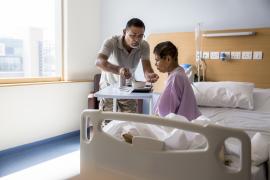BACKGROUND
Nearly all of Mexico’s 120 million citizens are covered by public insurance through plans linked to their jobs or through a nationally subsidized program known as Seguro Popular. Despite near-universal coverage, the Mexican government’s total public spending on health care is relatively low — 3.3 percent of gross domestic product (GDP) in 2014 — compared with public spending in more developed nations such as the United Kingdom (7.6% of GDP) and the United States (8.3% of GDP). Mexicans have one of the highest rates of out-of-pocket spending in Latin America, at 44 percent of all health expenditures.1
Although health services in Mexico are provided free at the point of care, the public system does not have the capacity to fully meet demand, leading to long wait times to see primary care providers and specialists.2 Rather than waiting, many people prefer to pay out of pocket to see private providers, despite the financial strain.
A Health Hotline in Mexico
Mexico does, however, have one of Latin America’s most sophisticated telecommunications industries as well as one of its fastest-growing middle classes. To the founders of MedicallHome, these two factors presented a market opportunity to expand access to health care through telemedicine.3 “We thought we could provide complementary health services to what was already available in the public and private sectors,” says Jorge Woolf, CEO of MedicallHome’s parent company, Salud Interactiva (Interactive Health). “We could make care affordable, available, [and] accessible.”
Mexico’s telecommunications industry is one of the most sophisticated in Latin America and reaches nearly all parts of the country. Rapid growth of landline coverage began in 1997, encouraged by regulatory changes.4 More recent growth in the mobile phone market, particularly through prepaid contracts that enable access for low-income populations, has made Mexico a leader in use of mobile phones, even in rural areas.5

Key Program Features
Rapid Response and Standard Protocols
MedicallHome, a brand of the company Salud Interactiva, provides telephone access to licensed doctors 24 hours a day, seven days a week, along with deep discounts at a national network of more than 10,000 health care providers in clinics, labs, and hospitals. Primarily targeting low- and middle-income households, MedicallHome packages are priced from $2 to $5 per month for a range of services. At the top range, the package includes life insurance, dental and vision discounts, and retail discounts, in addition to the standard MedicallHome service.
The Healthcare Contact Center at the heart of the of the MedicallHome model is staffed by 60 general practitioners, nutritionists, and licensed psychologists, all of whom must have at least two to three years of clinical experience. They also are required to continue practicing outside of the call center to maintain and strengthen their clinical skills. Doctors answer calls on average within 10 seconds and use standardized protocols developed in partnership with the Cleveland Clinic to identify emergencies within two minutes. With an average of 500,000 calls per year, the doctors resolve 62 percent of cases by phone and refer the remaining cases for in-person treatment. Mexican regulations prohibit doctors from prescribing medication over the phone without an in-person consultation, a policy that partially drives these referrals.
Affordable and Timely Access to Providers
MedicallHome subscribers receive timely and affordable services from a national network of providers in primary care and specialist clinics, labs, pharmacies, and hospitals, with coverage in every state and nearly 300 cities. Because of the high customer volume, MedicallHome can negotiate significant discounts with these providers.
It also has leveraged the high volume of subscribers to negotiate discounts on life insurance, eye care, and dental services as well as restaurants, entertainment, and travel.
Designed to Complement Existing Services
MedicallHome was developed to complement, not replace, medical insurance. As noted above, Mexico’s public health care delivery sector is unable to meet demand, and even low-income populations spend significant amounts of money out of pocket on private care. This creates a prime market for MedicallHome, which is perceived as more affordable and convenient than alternatives.
Moreover, because of the national surplus of general practitioners, MedicallHome can recruit high-quality doctors.6 General practitioners in Mexico typically hold positions at multiple hospitals and clinics and may have a private practice on the side. Shift work at a call center can be relatively easy for them to fit into their schedules.
Salud Interactiva’s leaders report that their providers can handle minor medical issues, such as consultations and laboratory tests, more efficiently than those employed by insurance companies, enabling insurance companies to focus on covering major medical events, such as surgery or hospitalization. Several private insurance companies have developed formal partnerships with MedicallHome to leverage this advantage, with some companies covering the cost of a MedicallHome subscription.
Business Model
MedicallHome was launched in 1998 with two doctors and one customer service representative. The company first tested a toll line before turning to direct sales through industry partners, a business model that has enabled it to expand rapidly throughout Mexico and form partnerships across sectors.
Salud Interactiva builds all infrastructure, support services, and information technology platforms (including mobile apps, call center software, and electronic health records) in house. It reaches new customers through corporate partnerships with major telecommunications and banking companies, including Telmex, the largest phone service provider in Mexico. A telemarketing campaign enrolls customers of these partner companies in its services. The company also reaches new customers by developing creative commercial partnerships. For example, a traveler purchasing a bus ticket with a partnering bus company can pay an additional 10 pesos (USD0.60) and access MedicallHome services during the trip. University students can purchase insurance from their school, including a MedicallHome subscription, for 300 pesos (USD18.50).
MedicallHome’s subscription model creates a steady revenue stream, keeps overhead low, and provides an efficient channel for billing through partners. MedicallHome is profitable and earnings grow every year.
The MedicallHome model launched in the Philippines in July 2015 as Konsulta MD, a joint venture between Salud Interactiva and Globe Telecom, the Philippines’ primary telecommunications provider, with 40 million customers. Filipinos are being offered a basic package (Healthcare Contact Center and ambulance referrals when needed), priced at PHP149 (USD3.20) per month for a family. Konsulta MD has established its own call center in the Philippines. Filipino regulations allow doctors to prescribe medications by telephone, averting the need for some referrals and generating additional savings for customers. The partners expect to realize profits within two years.
Results
MedicallHome tracks adherence to clinical standards and customer satisfaction. During each shift a supervisor audits 5 percent to 10 percent of all calls to measure fidelity to clinical protocols. Call center dashboards measure additional indicators related to provider etiquette, such as active listening (number of times a question is repeated), and these data are reviewed by supervisors during each shift. The company also regularly surveys customers to assess their satisfaction with the call center and provider network. There has not been an evaluation of the model’s impact on clinical outcomes.
This approach has the potential to reduce inefficient utilization of health care. For example, 6 percent of all MedicallHome callers believe they are experiencing a medical emergency. Of this population, call center physicians determine that only 12 percent are experiencing emergencies that require an ambulance and immediate acute care. The remainder may need urgent care but can avoid emergency departments and ambulance service, resulting in savings for the patient and the health system. In addition to the potential for cost reduction, the MedicallHome model provides a pressure-release valve in an overburdened public health system.

Potential for Spread in the United States
Elements of the MedicallHome model have been adapted to the U.S. through ConsejoSano (Healthy Advice), a joint venture launched in 2014 by Salud Interactiva and an independent, U.S.-based team. ConsejoSano founder and CEO Abner Mason saw an opportunity to leverage elements of the MedicallHome model to meet the needs of the millions of Spanish speakers living in the United States. After soliciting guidance from multiple law firms regarding telemedicine regulations, ConsejoSano created a model its leaders believe satisfies U.S. regulatory requirements, particularly around licensure.
ConsejoSano is designed primarily as a health navigation service, analogous to a personalized WebMD. Subscribers have 24/7 telephone access to the MedicallHome Healthcare Contact Center but, because of practice limitations, the Mexican doctors act as health advisers only; they are not considered to have physician–patient relationships with ConsejoSano clients. Callers are prompted to select advice related to general health, emotional health, or nutrition (with a focus on diabetes and obesity). The call is then routed to the MedicallHome call center in Mexico.
Unlike the MedicallHome model, which targets customers through telecommunications companies, ConsejoSano subscriptions are marketed primarily to large employers and health plans, though subscriptions are also sold directly to consumers. Every caller has a unique ID, which the call center doctors can use to look up their employer (if applicable), health information on record, and location. The doctors use standard MedicallHome protocols to determine whether callers need basic advice or should be referred to a clinician.
Priced to attract low-income workers, the annual subscription is $60 for an individual or $120 for a family of up to five when purchased through an employer or health plan. Employers and health plans may choose to partially or fully subsidize the cost of the ConsejoSano membership. A member’s first call initiates the annual membership fee and activates unlimited use of the service for a year. When sold directly to consumers, the plan is $120 per year for an individual or $180 for a family. Initially, ConsejoSano is marketing its services in the five states with 65 percent of the Hispanic population in the U.S.: California, Florida, Illinois, New York, and Texas.
Helping Hispanics Integrate into the U.S. Health Care System
ConsejoSano is designed to support integration with the existing health system, rather than bypassing it. Hispanics are the fastest-growing population in the U.S.; they are now nearly a fifth of the population and are projected to reach 30 percent by 2050.7 Yet many Hispanics are uninsured or underinsured.8 Through the Affordable Care Act (ACA) health insurance expansions, millions of Hispanics are projected to become newly insured.9 Indeed, 4.2 million Latino adults gained insurance coverage in 2014 and early 2015.10 However, there are not enough Spanish-speaking providers in the U.S. to meet demand. Many Hispanics disengage from the health care system because of language barriers and lack of knowledge about how it works.11 ConsejoSano’s focus on health system navigation is intended to help its members more effectively access local health networks.
The vast majority of ConsejoSano calls are resolved by phone, but health advisers can make referrals to local practitioners or local resources when needed. Though there is no analogue to MedicallHome’s national network of providers, ConsejoSano has developed a clinic locator system (currently operating for California and Texas) that allows call center doctors to find local providers with bilingual staff, based on a caller’s zip code. For uninsured callers, the system identifies federally qualified health centers and free clinics and can facilitate priority appointments. For corporate customers, they can identify in-network providers and discuss options included in the employee benefits package that are more cost-effective than urgent care or the emergency department.
ConsejoSano also offers educational videos for its customers, focused on preventive care and patient engagement. For example, one video explains how to use health insurance and the meaning of terms like “copayment” and “deductible.” Another video offers tips on healthy eating, using foods common to the Latin American diet.
ConsejoSano has attracted interested from employers seeking cost-effective health care services for their employees. In January 2016, Mercer, a global consulting firm that brokers health services for large corporations’ health plans, officially announced its alliance with ConsejoSano as a preferred vendor and ConsejoSano has since signed on large clients such as LaSalle Medical Associates and Unite Here Health.
The model’s emphasis on triaging patients to the most appropriate and efficient use of care could lead to cost savings in the U.S., helping people take advantage of less expensive resources in their communities and/or addressing medical problems before they become urgent. ConsejoSano reports that preliminary data indicate use of the call center service leads to a virtuous cycle of patient satisfaction and greater willingness to seek care in the future. The service also could help employees stay healthy and reduce absenteeism, although the data are insufficient to draw conclusions. ConsejoSano is partnering with LaSalle Medical Associates in California to test whether tailored text messaging can drive higher compliance with health care quality measures, such as childhood immunization rates, among a patient population that is covered largely by Medicaid.

Challenges
One challenge facing the ConsejoSano model is that Spanish-speaking doctors in the call center are located and licensed in Mexico. ConsejoSano operates as a health navigation service, and its providers are legally prevented from establishing doctor–patient relationships with callers from the U.S. Call center doctors offer general health and wellness advice, but do not make specific referrals. Even though ConsejoSano doctors are not providing specific advice, the arrangement creates a risk of uncoordinated care given the fact these doctors are not in touch with callers’ U.S.-based clinicians.
Developing a U.S.-based call center would allow call center doctors to offer medical advice (and would provide a market distinction from the nurse advice lines offered by many health plans and systems). However, it is important to note that the state-based physician licensure in the U.S. would make it hard to create a multistate or national call center. What’s more, the evolving nature of telemedicine regulation and reimbursement adds uncertainty about the viability of this model.
Nonetheless, the increasing acceptability and expansion of telehealth services in the U.S. indicate there may be potential for wider adaptation of the MedicallHome model. For example, in 2015 Walgreens expanded its telehealth platform — which gives subscribers 24/7 access to a network of U.S. board-certified physicians — beyond California and Michigan to users in Colorado, Illinois, and Washington. The company plans to offer services in 25 states.12 If this platform and similar ventures prove successful, the MedicallHome and ConsejoSano models may fill an important need in the U.S. telehealth market. Along with serving Spanish-speaking residents, the models have the potential to reach low-income, rural, and elderly populations, who face significant barriers to accessing care.


